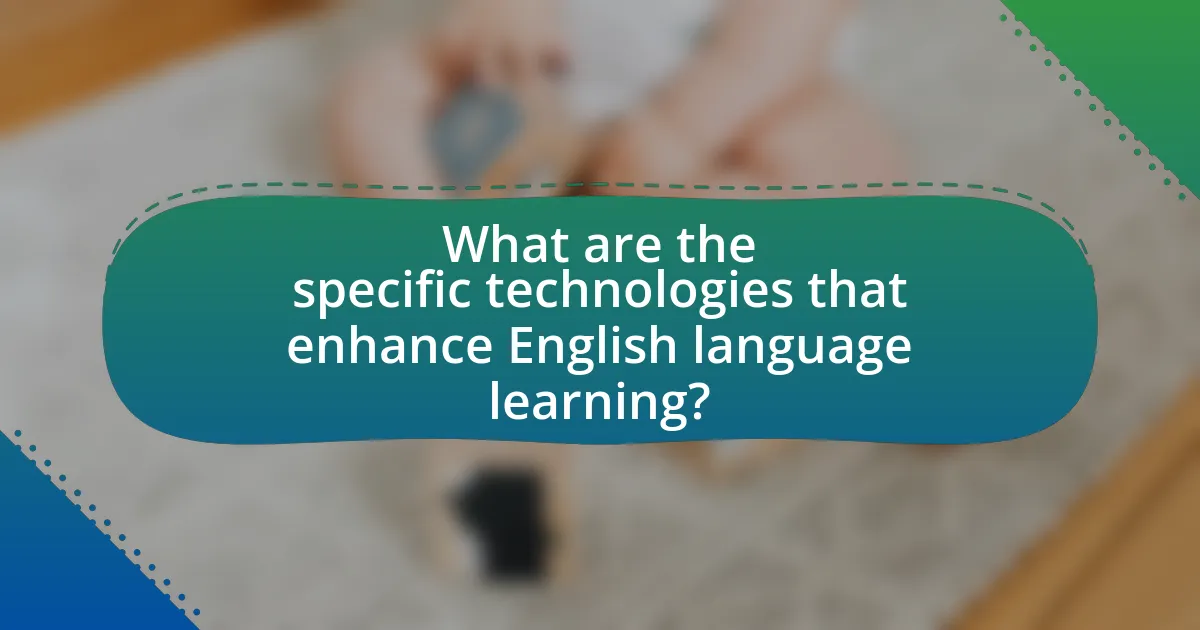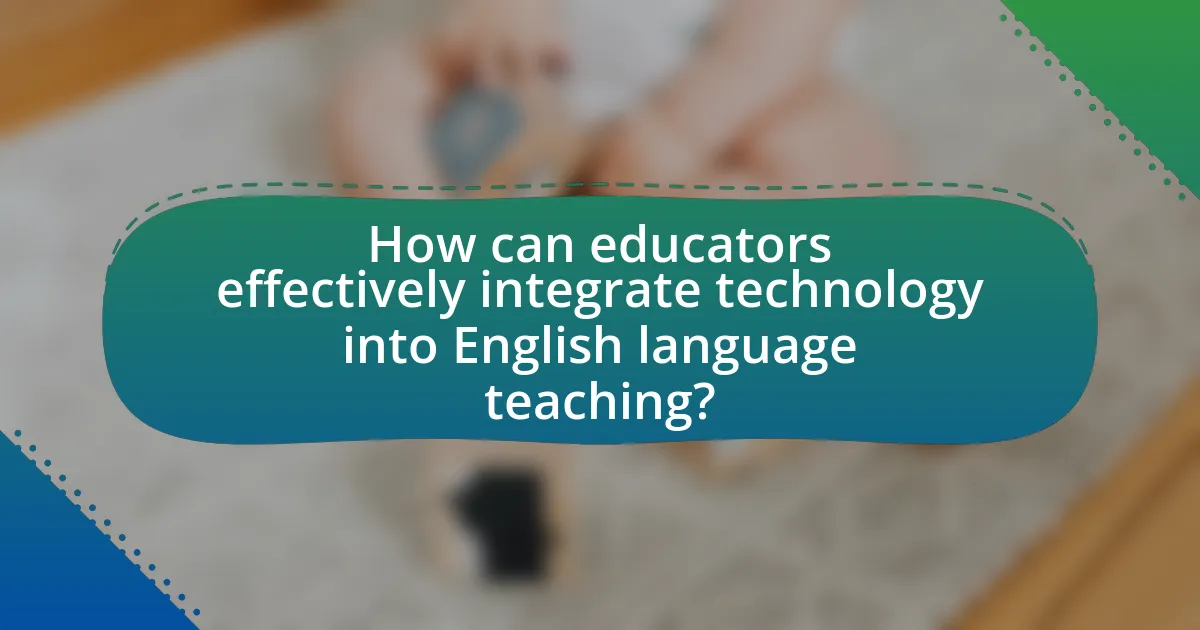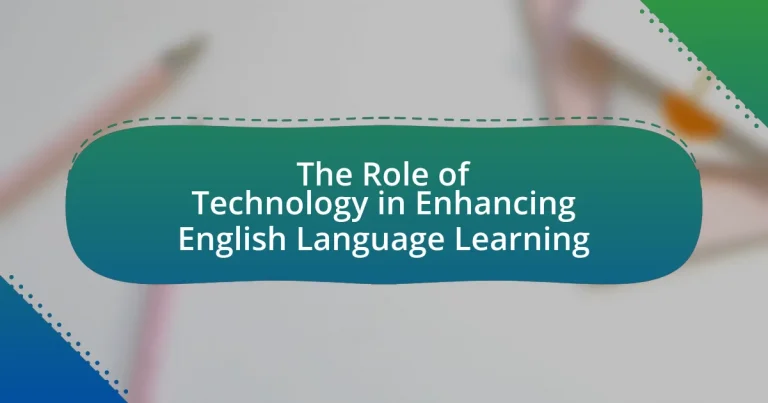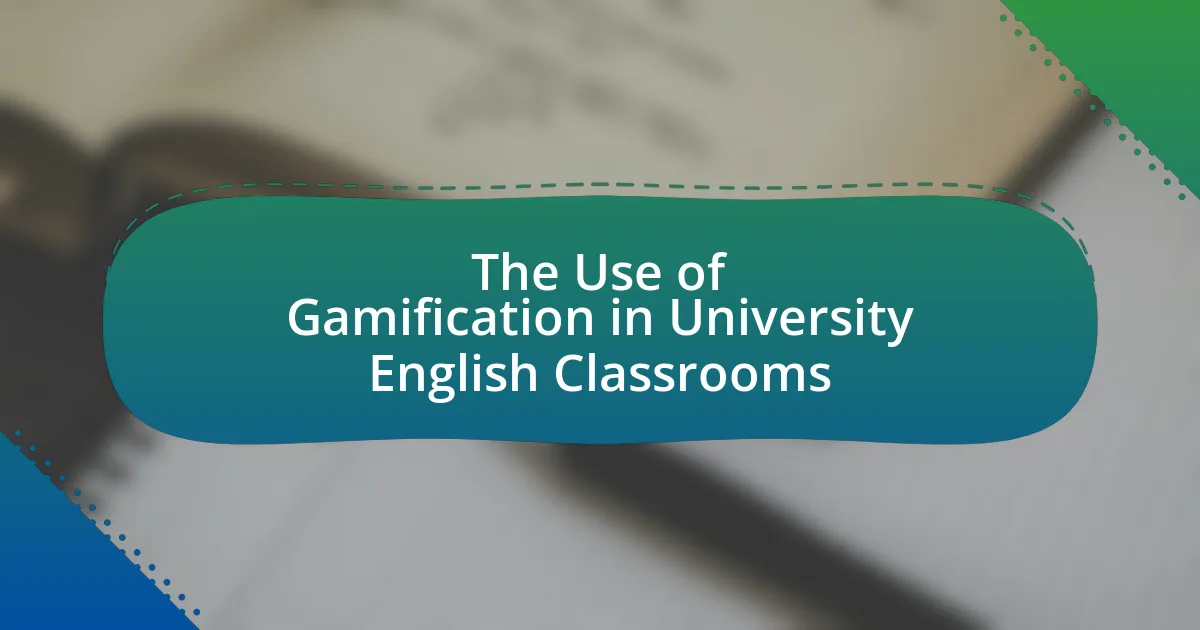The article examines the significant role of technology in enhancing English language learning, highlighting how digital tools and resources improve engagement, comprehension, and retention. It discusses the transformation of traditional learning methods through interactive platforms, mobile applications, and online courses, which provide personalized learning experiences. Key technological tools such as language learning apps, virtual classrooms, and multimedia resources are explored for their effectiveness in catering to diverse learning styles and facilitating language acquisition. Additionally, the article addresses the advantages technology offers to both learners and educators, as well as future trends that may shape language education.

What is the Role of Technology in Enhancing English Language Learning?
Technology plays a crucial role in enhancing English language learning by providing interactive tools and resources that facilitate engagement and comprehension. Digital platforms, such as language learning apps and online courses, offer personalized learning experiences, allowing learners to progress at their own pace. Research indicates that the use of multimedia resources, including videos and interactive exercises, significantly improves retention and understanding of language concepts. For instance, a study published in the “Journal of Educational Technology & Society” found that students using technology-enhanced learning environments showed a 30% increase in language proficiency compared to traditional methods. Additionally, technology enables access to authentic language materials, fostering real-world communication skills essential for fluency.
How has technology transformed traditional English language learning methods?
Technology has transformed traditional English language learning methods by introducing interactive and personalized learning experiences. Digital platforms, such as language learning apps and online courses, allow learners to access resources anytime and anywhere, facilitating self-paced study. For instance, Duolingo reported that its users spend an average of 34 hours per year learning a language, significantly increasing engagement compared to traditional classroom settings. Additionally, technology enables the use of multimedia resources, such as videos and podcasts, which cater to various learning styles and enhance comprehension. Research by the International Society for Technology in Education indicates that integrating technology in language learning improves student motivation and retention rates, demonstrating its effectiveness in modern education.
What are the key technological tools used in English language learning?
Key technological tools used in English language learning include language learning apps, online courses, interactive software, and virtual classrooms. Language learning apps like Duolingo and Babbel provide structured lessons and gamified experiences, enhancing engagement and retention. Online courses from platforms such as Coursera and edX offer comprehensive curricula designed by universities, allowing learners to study at their own pace. Interactive software, including Rosetta Stone, utilizes speech recognition technology to improve pronunciation and speaking skills. Virtual classrooms, facilitated by tools like Zoom and Microsoft Teams, enable real-time interaction with instructors and peers, fostering a collaborative learning environment. These tools collectively enhance accessibility, engagement, and effectiveness in learning English.
How do these tools facilitate language acquisition?
These tools facilitate language acquisition by providing interactive and personalized learning experiences. For instance, language learning applications utilize adaptive algorithms to tailor lessons based on individual progress, which enhances engagement and retention. Research shows that interactive tools, such as Duolingo, increase vocabulary retention rates by up to 34% compared to traditional methods. Additionally, multimedia resources, including videos and podcasts, expose learners to authentic language use, improving listening skills and cultural understanding. This combination of personalized feedback and exposure to real-world language contexts significantly accelerates the language acquisition process.
Why is technology important in modern English language education?
Technology is important in modern English language education because it enhances accessibility, engagement, and personalized learning experiences. Digital tools such as language learning apps, online courses, and interactive platforms provide learners with immediate access to resources and diverse content, facilitating self-paced study. Research indicates that technology integration in language education can improve student motivation and retention rates; for instance, a study published in the “Journal of Educational Technology & Society” found that students using technology for language learning showed a 30% increase in engagement compared to traditional methods. Furthermore, technology enables tailored instruction through adaptive learning systems that cater to individual learner needs, thereby optimizing the educational process.
What advantages does technology provide to learners and educators?
Technology provides numerous advantages to learners and educators, including enhanced access to resources, improved engagement, and personalized learning experiences. For learners, technology facilitates access to a vast array of educational materials and online courses, enabling them to learn at their own pace and according to their individual needs. For instance, platforms like Khan Academy and Duolingo offer tailored lessons that adapt to a learner’s proficiency level. Educators benefit from technology through tools that streamline lesson planning and assessment, such as Google Classroom and educational software that provides real-time feedback on student performance. Research indicates that technology integration in classrooms can lead to increased student motivation and achievement, as evidenced by a study published in the Journal of Educational Psychology, which found that students using technology-enhanced learning environments scored higher on assessments compared to those in traditional settings.
How does technology cater to different learning styles in English language learning?
Technology caters to different learning styles in English language learning by providing diverse tools and resources that accommodate visual, auditory, and kinesthetic learners. For instance, visual learners benefit from multimedia presentations, infographics, and videos that illustrate language concepts, while auditory learners engage with podcasts, audiobooks, and interactive speaking exercises. Kinesthetic learners can utilize language learning apps that incorporate gamification and hands-on activities, allowing them to practice language skills through movement and interaction. Research indicates that incorporating technology in language learning can enhance engagement and retention, as evidenced by a study published in the “Journal of Educational Technology & Society,” which found that students using technology-based resources showed improved language proficiency and motivation compared to traditional methods.

What are the specific technologies that enhance English language learning?
Specific technologies that enhance English language learning include language learning apps, online courses, virtual reality (VR), and artificial intelligence (AI) tools. Language learning apps like Duolingo and Babbel provide interactive exercises and gamified learning experiences, which have been shown to improve vocabulary retention and engagement. Online courses, such as those offered by platforms like Coursera and edX, allow learners to access structured content from reputable institutions, facilitating a comprehensive understanding of the language. Virtual reality technology immerses learners in simulated environments where they can practice conversational skills in real-time scenarios, enhancing speaking and listening abilities. AI tools, such as chatbots and personalized learning systems, adapt to individual learner needs, providing tailored feedback and practice opportunities, which research indicates can significantly boost language acquisition efficiency.
How do mobile applications support English language learners?
Mobile applications support English language learners by providing interactive and personalized learning experiences. These applications often include features such as vocabulary building exercises, grammar quizzes, and pronunciation practice, which cater to individual learning needs. For instance, a study by Stockwell (2010) found that mobile-assisted language learning can enhance vocabulary acquisition and retention, demonstrating the effectiveness of these tools in improving language skills. Additionally, mobile apps often incorporate gamification elements, making learning engaging and motivating, which further supports language acquisition.
What features make mobile apps effective for language learning?
Mobile apps are effective for language learning due to features such as interactive exercises, personalized learning paths, and gamification elements. Interactive exercises engage users through listening, speaking, reading, and writing tasks, which enhance language retention and practical application. Personalized learning paths adapt to individual progress and learning styles, ensuring that users receive tailored content that meets their specific needs. Gamification elements, such as rewards and challenges, motivate learners by making the process enjoyable and competitive. Research indicates that these features significantly improve user engagement and learning outcomes, as evidenced by studies showing that gamified learning environments can increase motivation by up to 50%.
Which popular mobile applications are recommended for English learners?
Popular mobile applications recommended for English learners include Duolingo, Babbel, and Rosetta Stone. Duolingo offers gamified language learning with bite-sized lessons, making it engaging and effective for users. Babbel focuses on conversation skills and real-life dialogues, providing practical vocabulary and grammar. Rosetta Stone emphasizes immersive learning through visual and audio cues, enhancing pronunciation and comprehension. These applications are widely recognized for their effectiveness in improving English language skills among learners.
What role do online platforms play in English language education?
Online platforms serve as essential tools in English language education by providing accessible resources, interactive learning environments, and opportunities for real-time communication. These platforms facilitate language acquisition through diverse methods such as video lessons, quizzes, and forums, which cater to various learning styles. For instance, a study by the British Council found that 70% of learners reported improved language skills through online courses, highlighting the effectiveness of digital resources in enhancing language proficiency. Additionally, platforms like Duolingo and Rosetta Stone utilize gamification to engage learners, making the process enjoyable and motivating.
How do online courses compare to traditional classroom settings?
Online courses offer greater flexibility and accessibility compared to traditional classroom settings. Students can learn at their own pace and access materials from anywhere, which is supported by a study from the Online Learning Consortium indicating that 70% of students prefer the convenience of online learning. In contrast, traditional classrooms typically require physical attendance and adhere to a fixed schedule, limiting options for those with work or family commitments. Additionally, online courses often utilize diverse multimedia resources, enhancing engagement and catering to various learning styles, while traditional settings may rely more heavily on lectures and textbooks.
What are the benefits of using online forums and communities for language practice?
Online forums and communities provide significant benefits for language practice by facilitating real-time interaction and diverse language exposure. These platforms allow learners to engage with native speakers and other learners, enhancing conversational skills and cultural understanding. Research indicates that participation in online language communities can lead to improved language proficiency, as users frequently practice writing and receive immediate feedback, which is crucial for language acquisition. A study by Thorne and Black (2007) in the “Language Learning & Technology” journal found that online interactions significantly enhance learners’ motivation and engagement, leading to better language outcomes.

How can educators effectively integrate technology into English language teaching?
Educators can effectively integrate technology into English language teaching by utilizing digital tools such as language learning apps, online resources, and interactive platforms. These technologies facilitate personalized learning experiences, allowing students to engage with content at their own pace and according to their individual needs. For instance, research by the International Society for Technology in Education (ISTE) indicates that using platforms like Duolingo or Quizlet can enhance vocabulary acquisition and retention among learners. Additionally, incorporating multimedia resources, such as videos and podcasts, can improve listening and comprehension skills, as supported by studies showing that students exposed to varied media formats demonstrate higher engagement and understanding.
What strategies can teachers use to incorporate technology in their lessons?
Teachers can incorporate technology in their lessons by utilizing interactive tools such as educational apps, online resources, and multimedia presentations. These tools enhance engagement and facilitate diverse learning styles. For instance, using platforms like Kahoot! for quizzes or Google Classroom for assignments allows for real-time feedback and collaboration among students. Research indicates that integrating technology in education can improve student motivation and learning outcomes, as evidenced by a study published in the Journal of Educational Technology & Society, which found that technology-enhanced learning environments lead to higher academic performance.
How can teachers assess the effectiveness of technology in their teaching?
Teachers can assess the effectiveness of technology in their teaching by evaluating student engagement, learning outcomes, and feedback. By analyzing metrics such as test scores, participation rates, and completion of assignments, educators can determine if technology enhances understanding and retention of English language concepts. Research indicates that technology integration can lead to improved student performance; for instance, a study by Tamim et al. (2011) found that technology use in classrooms positively correlates with academic achievement. Additionally, gathering qualitative feedback from students about their experiences with technology can provide insights into its impact on motivation and learning processes.
What challenges might educators face when implementing technology in the classroom?
Educators may face several challenges when implementing technology in the classroom, including lack of training, resistance to change, and unequal access to resources. Lack of training can hinder effective use of technology, as teachers may not be familiar with the tools or how to integrate them into their curriculum. Resistance to change often stems from comfort with traditional teaching methods, making it difficult for educators to adopt new technologies. Additionally, unequal access to technology can create disparities among students, as not all students may have the same level of access to devices or reliable internet, which can affect their learning experience. These challenges are supported by research indicating that effective technology integration requires adequate professional development and equitable access to resources.
What best practices should be followed when using technology for English language learning?
Best practices for using technology in English language learning include integrating interactive tools, utilizing multimedia resources, and fostering collaborative learning environments. Interactive tools, such as language learning apps and online quizzes, enhance engagement and provide immediate feedback, which is crucial for language acquisition. Multimedia resources, including videos, podcasts, and digital storytelling, cater to various learning styles and improve comprehension skills. Collaborative learning environments, facilitated by platforms like discussion forums and group projects, encourage communication and peer interaction, essential for practicing language skills. Research by the International Society for Technology in Education highlights that these practices significantly improve learner motivation and outcomes in language learning contexts.
How can teachers ensure that technology enhances rather than hinders learning?
Teachers can ensure that technology enhances learning by integrating it purposefully into their lesson plans and aligning it with educational objectives. This involves selecting tools that support interactive and collaborative learning, such as language learning apps and online discussion platforms, which have been shown to improve student engagement and language acquisition. Research indicates that when technology is used to facilitate communication and provide immediate feedback, such as through platforms like Duolingo or Google Classroom, students demonstrate higher retention rates and improved language skills. Additionally, teachers should regularly assess the effectiveness of technology in their classrooms, making adjustments based on student feedback and learning outcomes to ensure that it remains a beneficial resource rather than a distraction.
What resources are available for teachers to improve their technological skills?
Teachers can improve their technological skills through various resources such as online courses, professional development workshops, and educational technology websites. Online platforms like Coursera and edX offer courses specifically designed for educators to enhance their tech proficiency, often in collaboration with universities. Professional development workshops, often provided by school districts or educational organizations, focus on integrating technology into teaching practices. Additionally, websites like Edutopia and ISTE (International Society for Technology in Education) provide articles, webinars, and community forums that support teachers in learning about new tools and strategies for effective technology use in the classroom. These resources are widely recognized in the education community for their effectiveness in helping teachers adapt to technological advancements.
What are the future trends in technology for English language learning?
Future trends in technology for English language learning include the increased use of artificial intelligence, personalized learning experiences, and immersive technologies such as virtual and augmented reality. Artificial intelligence will enable adaptive learning platforms that tailor content to individual learner needs, enhancing engagement and effectiveness. Personalized learning experiences will leverage data analytics to track progress and adjust teaching methods accordingly, fostering a more efficient learning environment. Immersive technologies will provide learners with realistic contexts for language use, improving retention and practical application. These trends are supported by research indicating that technology integration significantly enhances language acquisition outcomes.
How might artificial intelligence shape the future of language education?
Artificial intelligence will significantly shape the future of language education by providing personalized learning experiences tailored to individual student needs. AI-driven platforms can analyze a learner’s strengths and weaknesses, adapting content and pacing accordingly, which has been shown to enhance engagement and retention rates. For instance, research from the University of Cambridge indicates that personalized learning through AI can improve language acquisition by up to 30% compared to traditional methods. Additionally, AI can facilitate real-time feedback and assessment, allowing learners to practice speaking and writing skills with immediate corrections, further accelerating their progress.
What emerging technologies should educators be aware of for language learning?
Educators should be aware of artificial intelligence, virtual reality, and mobile applications as emerging technologies for language learning. Artificial intelligence, through tools like chatbots and personalized learning platforms, enhances engagement and provides tailored feedback, improving language acquisition. Virtual reality offers immersive environments that simulate real-life interactions, allowing learners to practice language skills in context. Mobile applications facilitate on-the-go learning, providing access to resources and practice opportunities anytime, anywhere. These technologies have been shown to increase motivation and retention in language learners, making them essential for modern educational practices.
What practical tips can enhance the use of technology in English language learning?
Utilizing technology effectively in English language learning can be enhanced through several practical tips. First, incorporating language learning apps like Duolingo or Babbel can provide interactive and engaging practice, which has been shown to improve vocabulary retention and grammar skills. Research indicates that mobile-assisted language learning can lead to increased motivation and self-directed learning among students. Additionally, using online platforms for conversation practice, such as language exchange websites or video conferencing tools, allows learners to engage with native speakers, enhancing their speaking and listening skills. Furthermore, integrating multimedia resources, such as podcasts and videos, can cater to different learning styles and make the learning experience more dynamic. Studies have demonstrated that exposure to authentic language use through these mediums can significantly improve comprehension and fluency. Lastly, utilizing digital tools for collaborative projects, such as Google Docs or online forums, fosters communication and teamwork, essential skills in language acquisition.



